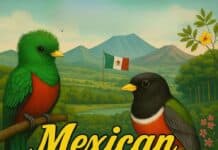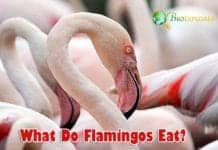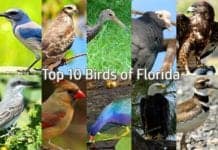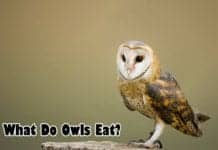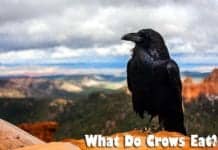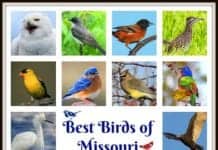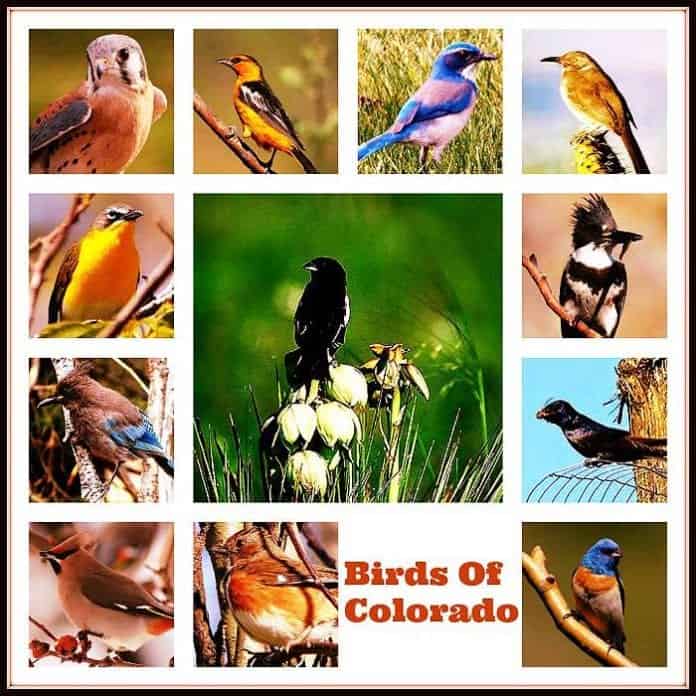
Birds of Colorado: The state of Colorado has a wide range of potential bird habitats: from grasslands to alpine forests and even tundra. As a result, this state of Colorado is home and nesting ground to very diverse bird species.
Birds of Colorado
Here are some choice examples of amazing Colorado birds.
Lark Bunting (State bird of Colorado)
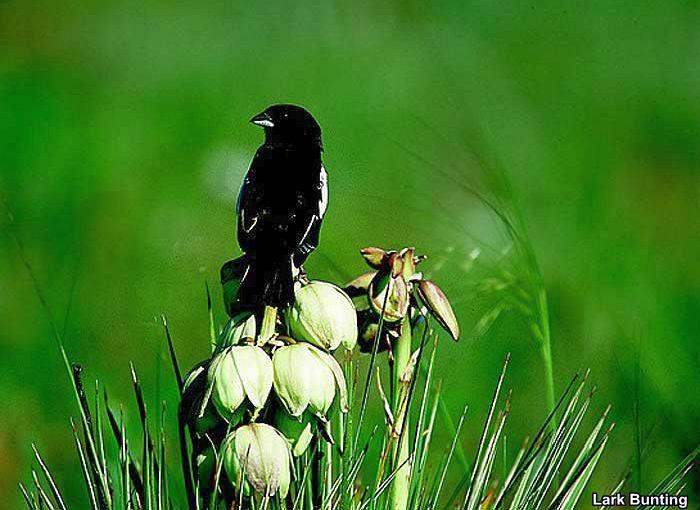 The first bird of Colorado in our listing is Lark bunting, which is a relative of the common sparrow.
The first bird of Colorado in our listing is Lark bunting, which is a relative of the common sparrow.
| Animalia | Passeriformes | Emberizidae | Calamospiza | Calamospiza melanocorys |
- This bird is known for its striking coloring in mature male birds.
- They are deep black with elegant white coloring on the wings. Females and immature birds have more common brown coloring.
- They can be differentiated from other brown-colored birds by a pale stripe over the eye and beak and a white patch on the throat.
- Sometimes wings of the immature males may have a white stripe. One can meet lark buntings on the Great Plains, though their population has declined since 1996.
Interesting Facts about Lark Buntings:
- Lark bunting was chosen as a Colorado state bird in 1931.
- This bird has been named very different names both in Latin and English, including prairie finch, black-headed finch, and white-winged blackbird.
- Lark bunting males are famous for their mating flight, when they rapidly ascend, descend, and sing as they fly down.
- Sometimes, lark bunting males function as “nest helpers” for established bird couples if they cannot find a partner.
- Lark buntings have two types of songs: the main mating song and a song for the rival males.
![]()
Lazuli Bunting
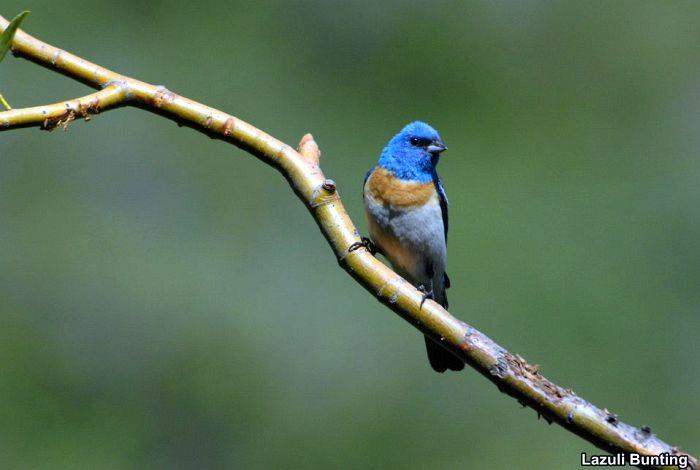 This bunting is widespread in the Western States of the USA.
This bunting is widespread in the Western States of the USA.
| Animalia | Passeriformes | Cardinalidae | Passerina | Passerina amoena |
- The name of this bird is due to the striking plumage of the male birds during the breeding season.
- The males have a body-colored in different shades of blue, and the throat is pale red.
- Females are less conspicuous; they are colored brown and can be identified as lazuli buntings by the distinct white bars on their wings.
Interesting Facts about Lazuli Buntings:
- These birds are known to prefer pine forests and thickets;
- Females and males have different hunting strategies. The males choose open perches in the trees and fly to catch the insects. The females behave differently: they hide on their perches and fly out of their hideouts when they spot prey.
- The male lazuli buntings are known songbirds. They like to sing from perches.
- Though lazuli buntings prefer to hunt insects, they occasionally visit bird feeders.
- Each male develops their song when they reach about a year of age and develops it with time.
![]()
‘MacGillivrays Warbler
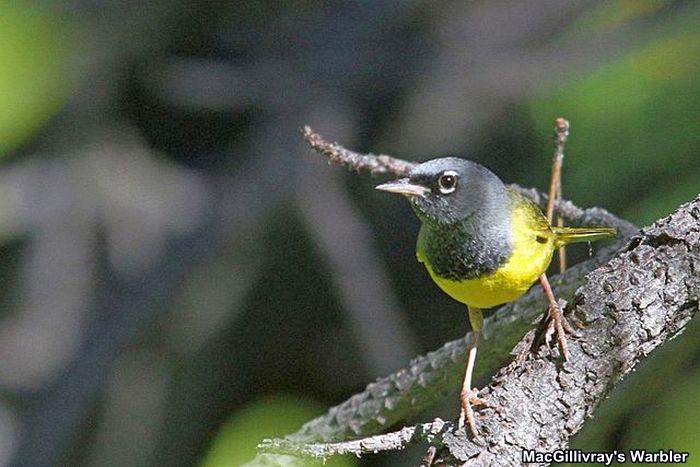 The next bird of Colorado is warbler, and it is a relatively small, roundish bird.
The next bird of Colorado is warbler, and it is a relatively small, roundish bird.
| Animalia | Passeriformes | Parulidae | Geothlypis | Geothlypis tolmiei |
- Both sexes have a grey hood, white patches around the eyes, and yellow breasts.
- The males have brighter coloring – bright yellow breasts and olive-colored wings.
- These small birds have a relatively small, sharp beak. These birds can be usually seen in coniferous forests around the Rocky Mountains.
Interesting Facts about MacGillivray’s Warblers:
- This warbler has its own song – a series of “tschurr” syllables, ending with a warble.
- The females are known to “scold” the intruders that come near their nests;
- Unlike many species, this warbler species benefits from industrial logging – it usually leaves in shrubs and the growth that appears after the felling of the trees.
- Previously, it was thought that warblers of Saskatchewan and South Dakota are different from the warblers of Rocky Mountains – it is now known it is all the same species, Geothlypis tolmei.
- This bird was given two names: Tolmei’s warbler after a respected ornithologist from Hudson Bay Company and McGillivray’s warbler, a Scottish ornithologist and a close friend of J. Audubon.
![]()
Bullock’s Oriole
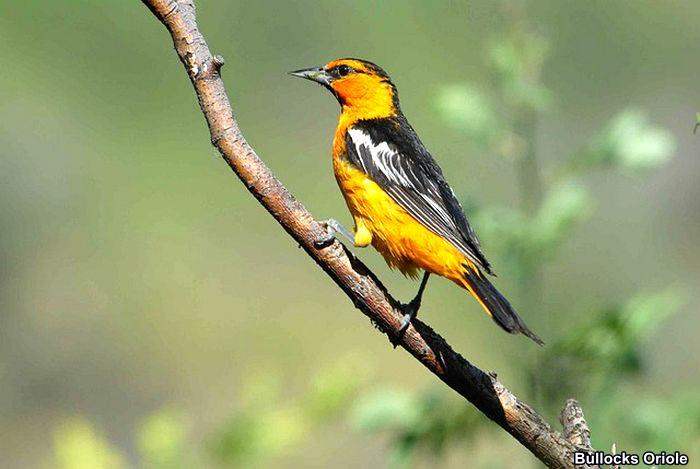 This bright Colorado bird lives in the woods that grow around the river banks.
This bright Colorado bird lives in the woods that grow around the river banks.
| Animalia | Passeriformes | Icteridae | Icterus | Icterus bullockii |
- It is widespread in the Western USA up to California and in Western Mexico.
- The male orioles are colored oranges with a black hood, wings, a part of the throat, as well as the areas around the eyes.
- Female coloring is more subdued, closer to yellow-orange on the body and chest and gray on the back and wings.
- Both sexes have a distinct white patch on the wings.
Interesting Facts about Bullock’s Orioles:
- This bird has a mixed diet – it eats insects and fruit, drinks nectar, and likes to visit bird feeders.
- In the Great Plains, this species is known to interbreed with Baltimore Oriole;
- This bird was referred to as “the most beautiful bird in its group discovered in Mexico“.
- The hybrids of Baltimore and Bullock’s oriole used to be named as a separate species – Northern Oriole;
- Both male and female orioles can sing.
![]()
Yellow-breasted Chat
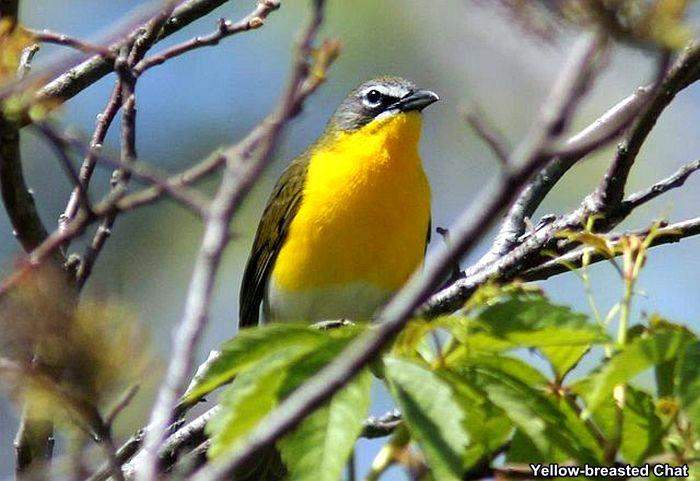 The yellow-breasted chat is a relatively large songbird in Colorado.
The yellow-breasted chat is a relatively large songbird in Colorado.
| Animalia | Passeriformes | Parulidae | Icteria | Icteria virens |
- The males have striking coloring: a yellow breast and olive-colored body, wings, and head.
- There are white circles around the bird’s eyes. It has a heavy bill and a long tail.
- They breed in the Eastern United States and Southern Canada and winter in Central America.
- In Colorado, they are seen mainly in summer.
Interesting Facts about Yellow-breasted Chats:
- Despite being considered a warbler, this bird has many non-warbler characteristics, such as the type of songs it sings and the large, stout bill.
- This chat is similar to a mockingbird – it can learn the sounds and songs of other birds and incorporate them into its own.
- These birds are usually shy and tend to sing out of the thicket, hidden away.
- Yellow-breasted chats are very talkative, and their song is very variable.
- The males of the species can share songs, determining territory and dominance in this way.
![]()
Eastern Towhee
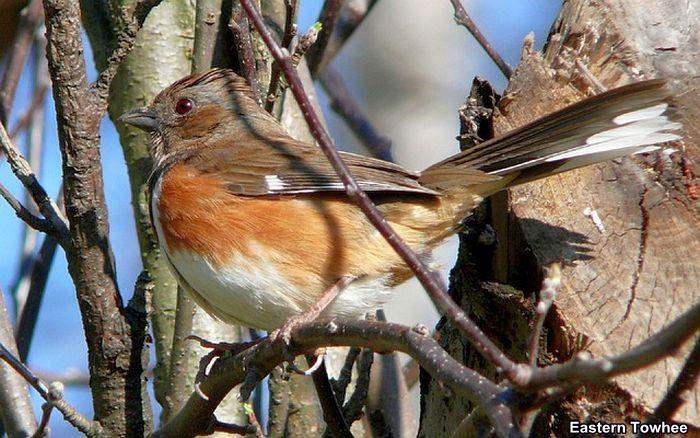 This bird of Colorado resembles a finch in size and form.
This bird of Colorado resembles a finch in size and form.
| Animalia | Passeriformes | Emberizidae | Pipilo | Pipilo erythrophthalmus |
- Its bulky body, head, and wings are colored black. The upper parts of the wings have rusty brown patches.
- There are also white patches on the wings themselves. The breast of the eastern towhee is white.
- There are also white patches in the long tail of the towhee. The beak of this bird is short, thick, and conical in shape.
- The eyes of the eastern towhee are conspicuously red.
- The females have a similar coloring with brown feathers instead of black ones, and the coloring of other parts is more subdued.
Interesting Facts about Eastern Towhees:
- Though eastern towhees resemble finches, they are related to sparrows.
- These birds search for food on the ground, scratching at the leaves with both feet, making “hopping” motions.
- This bird was called a “towhee” because of the sounds it makes during its song.
- To prove to the female his worth, the male towhee brings her different building materials for the nest.
- Both the male and the female of eastern Towhee defend the nest from intruders.
![]()
Bohemian Waxwing
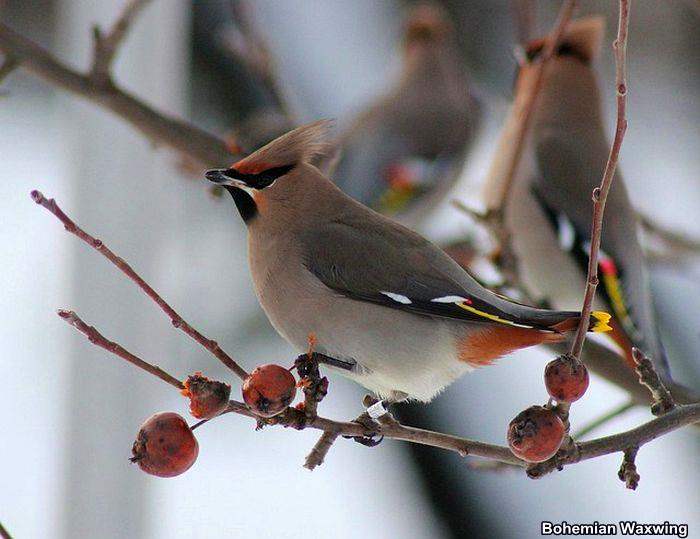 The next bird from Colorado is Bohemian waxwing, which is about the size of a starling.
The next bird from Colorado is Bohemian waxwing, which is about the size of a starling.
| Animalia | Passeriformes | Bombycillidae | Bombycilla | Bombycilla garrulus |
- These Colorado birds have a prominent head crest.
- Overall body is gray with distinct areas of a different color.
- The Bohemian waxwing bird has a black mask around the eyes and bill. One can also note the “blushing” patches around the cheeks and forehead.
- The wings of the bohemian waxwing have distinct white patches on the edges.
- The undertail of the waxwing is rusty, and there is a yellow tip on the end of the tail.
- The bird is called “waxwing” because of the red tips of the secondary wing feathers that look like a wax seal.
Interesting Facts about Bohemian Waxwings:
- Bohemian waxwings form large, social groups. These groups can contain up to a thousand birds.
- These birds love acrobatics and can dangle from branches to get to the fruit.
- Bohemian waxwings inhabit two distinct areas during life: they breed in evergreen forests of northern regions – such as Alaska, Siberia, or Scandinavia. During the non-breeding season, they can be seen in parks and around lakes.
- During courtship, male and female birds hop around on branches, chirping and exchanging food.
- In Europe, some Bohemian waxwings were proven to live up to 12 years.
![]()
Curve-billed Thrasher
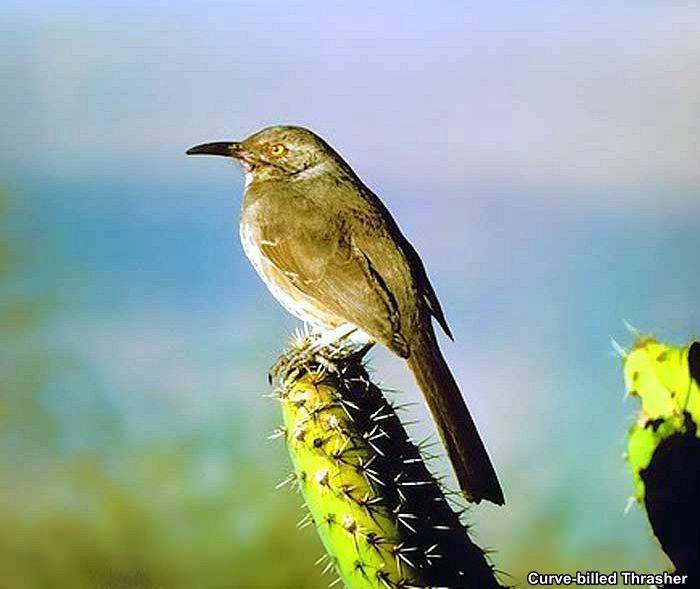 This Colorado bird is a thrasher of medium size, with grey upperparts.
This Colorado bird is a thrasher of medium size, with grey upperparts.
| Animalia | Passeriformes | Mimidae | Toxostoma | Toxostoma curvirostre |
- It lives in deserts and semi-deserts.
- The lower parts are also gray and spotted.
- This bird has orange-red eyes. As the name suggests, it has a long bill that is curved downwards.
- This thrasher has a long, dark grey tail.
- The species can be found in Colorado, Oklahoma, Texas, and New Mexico.
Interesting Facts about Curve-billed Thrashers:
- This bird likes to live where cholla cacti, mesquite, or palo verde grow.
- These birds have no defined song – the males just make abrupt warbles from perches.
- The curved bill of this thrasher bird is used to dig in soil in search of insects or seeds.
- This bird tends to nest on cholla cacti or spiky shrubs for protection.
- This bird likes to feed on cacti fruit to get both water and nutrients.
![]()
Mountain Bluebird
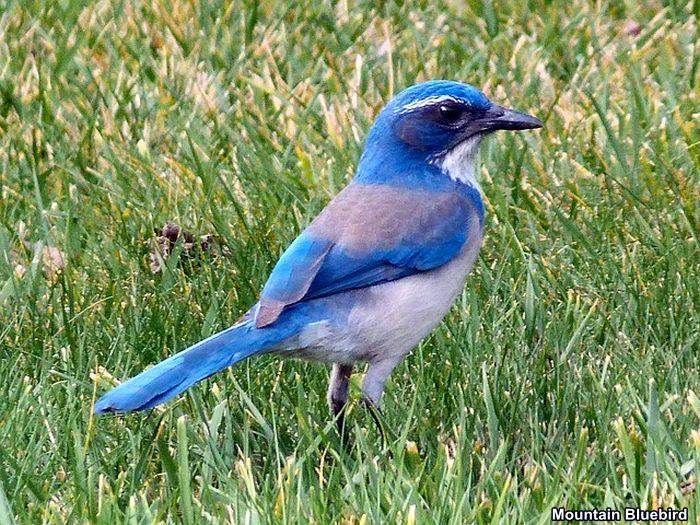 The males of this Colorado bird species are considered the most beautiful birds of the West.
The males of this Colorado bird species are considered the most beautiful birds of the West.
| Animalia | Passeriformes | Turdidae | Sialia | Sialia currucoides |
- An adult male mountain bluebird is small and stocky. The head of the bird is round, and the bill is short and thin.
- The males are sky blue. The upper parts of the body are usually of a darker color than the lower ones.
- The females only have small blue patches on the wings, and their overall body is gray-brown.
- Their bellies can be either rusty or brown. Both sexes have long wings and tails.
- These birds can also be found in the West of the USA.
Interesting Facts about Mountain Bluebirds:
- These birds are adapted to various habitats, from the prairie to the alpine tundra.
- Mountain bluebirds prefer elevated, open spaces.
- Mountain bluebirds hover while searching for food and prefer to jump on their prey from an elevated vantage point.
- In the wild, mountain bluebirds use abandoned woodpecker’s nests to breed their young. With the introduction of bird boxes, they began to use them as well.
- The male mountain bluebirds make some attempts at helping in nest building – still, it is usually the female that does all the work.
Suggested Readings:
Top 18 BEST Tundra Animal Adaptations
![]()
Blue-gray Gnatcatcher
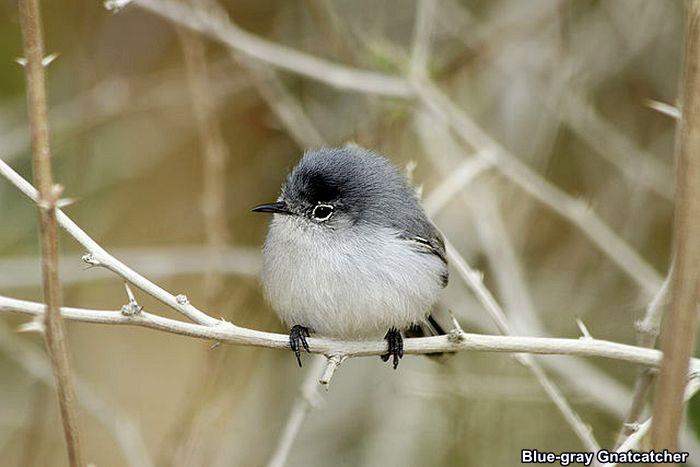 The next bird of Colorado is very tiny and it has a long tail, roundish body and a short, thin bill.
The next bird of Colorado is very tiny and it has a long tail, roundish body and a short, thin bill.
| Animalia | Passeriformes | Polioptilidae | Polioptila | Polioptila caerulea |
- The upper body is colored in soft blue-gray; the lower parts of the body are slightly paler.
- The males of mountain bluebirds can be distinguished from females by a black stripe on the forehead.
Interesting Facts about Blue-gray Gnatcatchers:
- There are at least 7 subspecies of this gnatcatcher.
- The calls of the blue-gray gnatcatcher resemble mewling.
- This bird usually tries to stay hidden in the trees and comes out only to quickly catch an insect.
- The males can fight during the breeding season, and one can hear their bills snapping during the conflict.
- The male gnatcatchers are so territorial and aggressive that they can chase away bigger birds from their feeding grounds.
![]()
Purple Martin
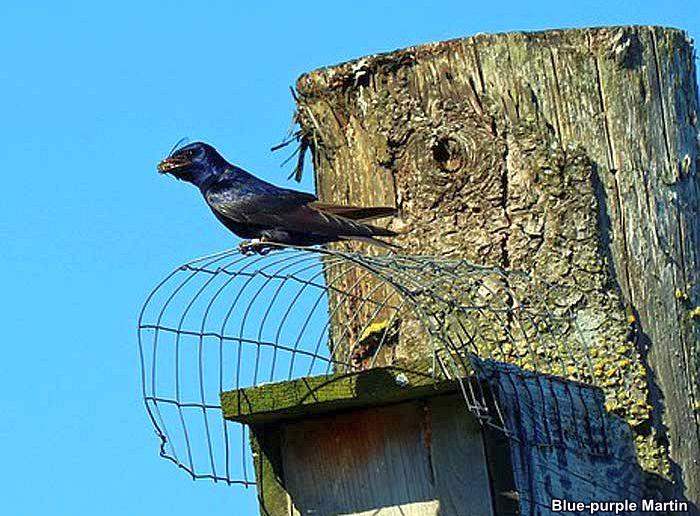 Purple martins belong to the swallow family and native to state of Colorado.
Purple martins belong to the swallow family and native to state of Colorado.
| Animalia | Passeriformes | Hirundinidae | Progne | Progne subis |
- The male purple martins have a dark, glossy blue coloring.
- The females are brown, with purple plumage on their heads and upper bodies.
- The feathers of purple martins are iridescent. Both sexes have an elongated body and a typical “sparrow” head with a short bill.
- They also have a forked tail.
Interesting Facts about Purple Martins:
- The plumage of the purple martins develops gradually over several years.
- The population east of the Rocky Mountains depends on man-made housing. In contrast, populations located west of the Rocky Mountains and in the desert prefer to nest in abandoned woodpecker nests.
- Native Americans hung empty gourds to provide purple martins with housing.
- The purple martins like condo-type housing, as they tend to roost and nest together.
- To prevent other sparrows from nesting in the houses intended for martins, placing their houses precisely during their migration time is essential.
![]()
Steller’s Jay
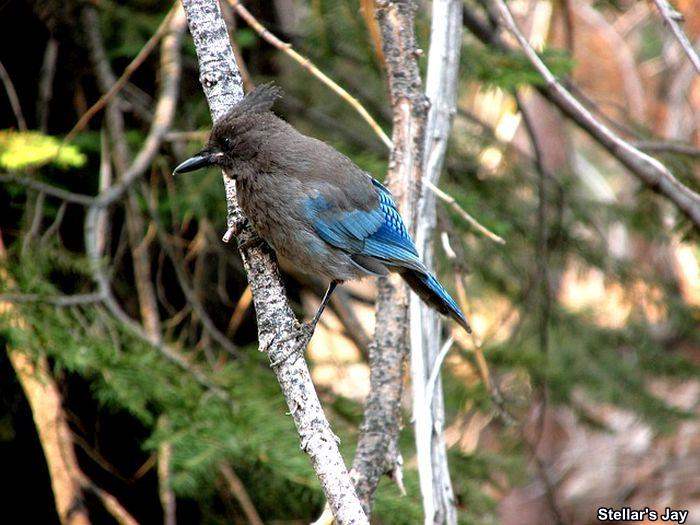 This Colorado bird shares the same family with crows and magpies.
This Colorado bird shares the same family with crows and magpies.
| Animalia | Passeriformes | Corvidae | Cyanocitta | Cyanocitta stelleri |
- Steller’s jay is a medium-sized bird, more significant than a robin and smaller than a crow.
- These birds have a distinct crest on their heads.
- The head and upper body of the Steller’s jay are deep black, while the lower body, including the tail, is blue.
- They also have distinct white markings around the eyes.
Interesting Facts about Stellar’s Jays:
- This species was discovered by George Wilhelm Steller in 1741 when the German naturalist was in Alaska.
- These birds are known to be aggressive and noisy.
- Steller’s jays are known to steal cat food.
- Both parents of Steller’s jays participate in nest building and feeding the young.
- Steller’s jays are excellent sound imitators.
![]()
American Kestrel
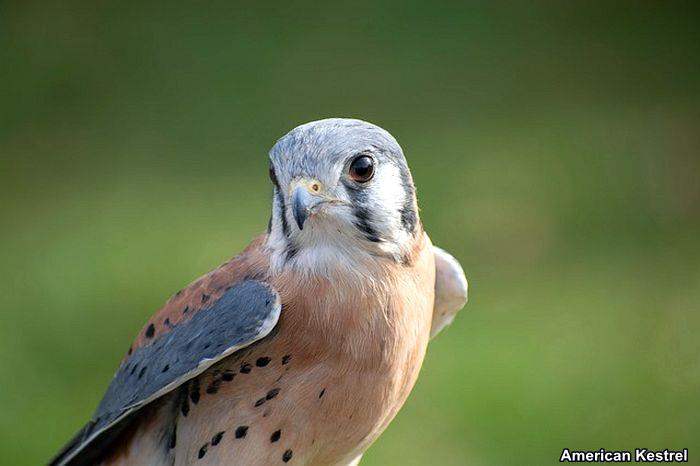 This next bird of Colorado is a small and very colorful North American falcon.
This next bird of Colorado is a small and very colorful North American falcon.
| Animalia | Falconiformes | Falconidae | Falco | Falco sparverius |
- This kestrel is about the size of a dove. It has a small head and long, narrow wings.
- Another typical feature of the American kestrel is a square tail. The males of this species are rusty-colored above the wings and have a white chest with spots.
- The wings themselves are blue-gray. The female kestrels have rusty bodies with black bars on the wings and back.
- Both sexes of this Colorado bird have black slash markings around the eyes.
Interesting Facts about American Kestrels:
- During hunting, they hover in the sky, looking for prey.
- The tails of American kestrels help them gain balance during flight.
- In the areas with few trees, American kestrels can perch on telephone wires.
- These kestrels nest in tree cavities and may even use nesting boxes.
- American kestrels nest in the same place for many years.
![]()
Williamson’s Sapsucker
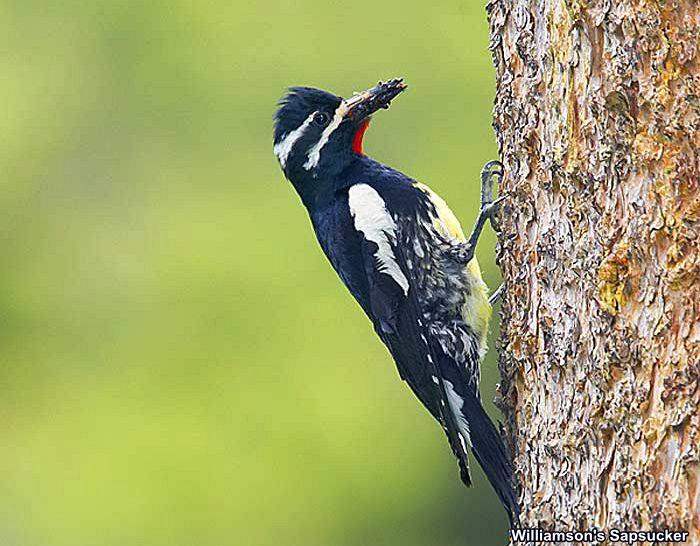 The next Colorado bird is sub-species of woodpecker family often seen in western mountains of the USA.
The next Colorado bird is sub-species of woodpecker family often seen in western mountains of the USA.
| Animalia | Piciformes | Picidae | Sphyrapicus | Sphyrapicus thyroideus |
- Adult males and females look very different.
- The males have a black upper body, with white stripes near the bill and the eyes.
- They also have a bright red patch on the throat. The lower body is spotted white, with an occasional yellow patch.
- The underside of the wings also has white feathers. The plumage of the female Williamson’s sapsuckers is far less bright.
- The female birds have an overall brown body and a brown head. There is a black chest patch that is almost unnoticeable.
- There can be a yellow patch on the underparts of the body. The females also may have black bars on the wings and the back.
Interesting Facts about Williamson’s Sapsuckers:
- Williamson’s sapsucker is strongly associated with conifer trees such as pine and or fir.
- Williamson’s sapsucker feeds on the sap of conifer trees, mainly pine, and it can also supplement its diet with fruit and insects stuck in the sap.
- For almost two decades, male and female Williamson’s sapsuckers were considered different species.
- These sapsuckers build a new nest every year, sometimes even in the same tree.
- Williamson’s sapsuckers feed their young ants.
![]()
Belted Kingfisher
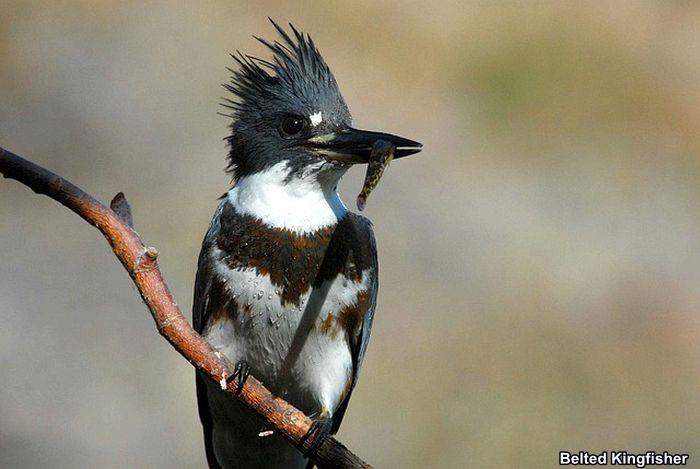 This last charismatic Colorado bird is widespread across North and Central America.
This last charismatic Colorado bird is widespread across North and Central America.
| Animalia | Coraciiformes | Alcedinidae | Megaceryle | Megaceryle alcyon |
- It has a typical bushy crest on its head. The head and the back of this bird are bluish-grey.
- A distinct white color is under the belted kingfisher’s head.
- The males of belted kingfisher can be distinguished from females by bands on the chest.
- The male kingfishers have one blue band across the white chest, while females have both a blue and chestnut-colored band.
- Both sexes have white stripes on the underside of the tale.
- The kingfisher bill is very recognizable – it is long, sharp, and quite thick and can open very wide.
Interesting Facts about Belted Kingfishers:
- The female belted kingfishers are more brightly colored than males.
- Kingfishers have benefitted from human activity: digging and road building have led to artificial river banks these birds can use as breeding sites.
- The belted kingfisher’s nest resembles a burrow or a tunnel in a riverbank.
- Sometimes kingfishers can let sparrows use their tunnels for nests as well.
- The oldest known kingfisher fossil is around 2 million years old.
![]()
As you can see, the bird world of Colorado State is hugely variable, with many very diverse and bright species.
The variety of ecosystems attracts winged guests from all around the continent, to the delight of birdwatchers.
![]()



